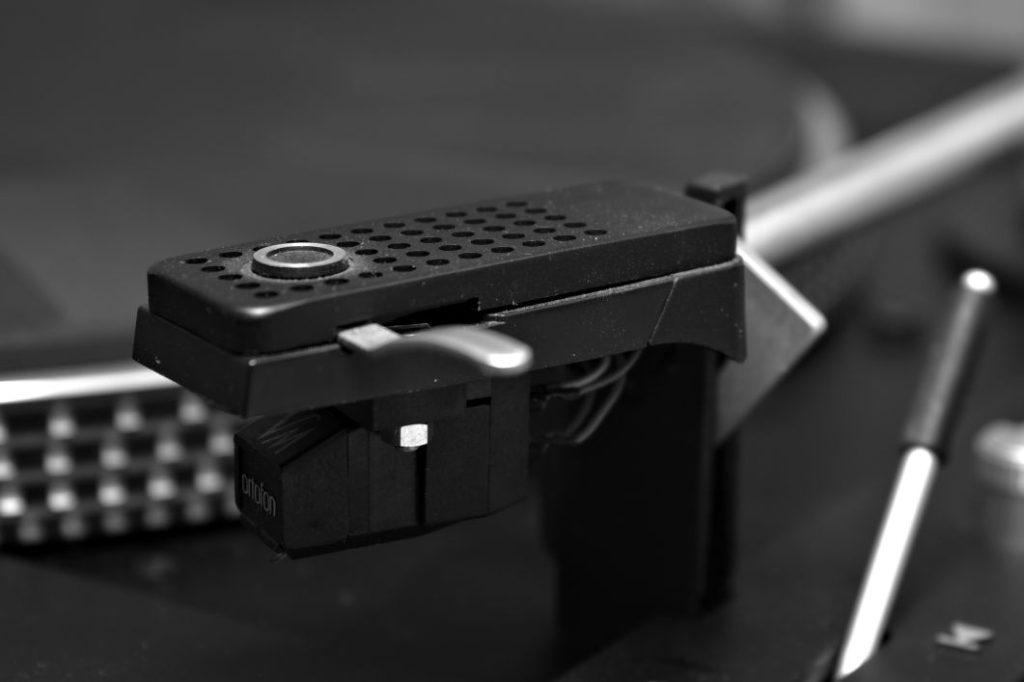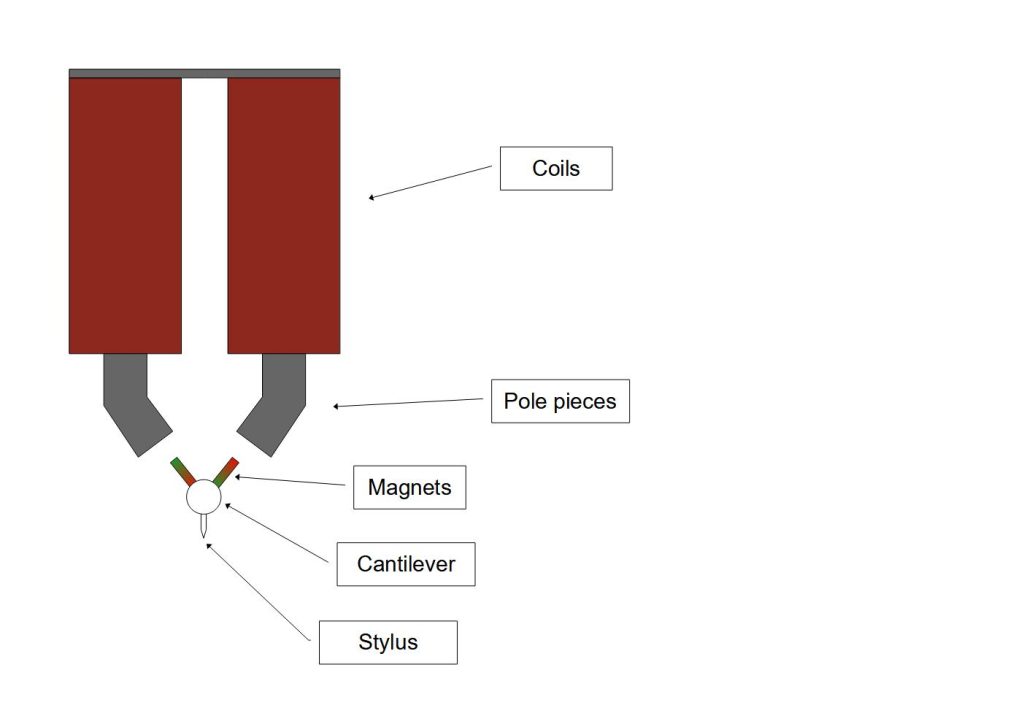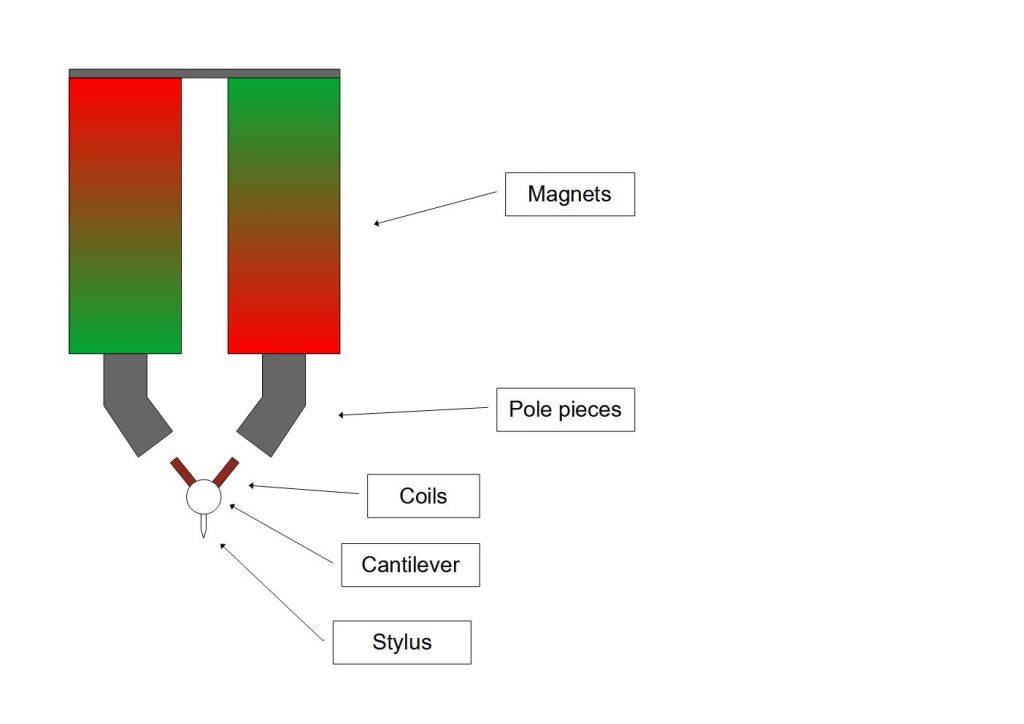What makes up a very small physical part of the record player but has a huge impact on the sound? That’s right, we’re talking about the magnetic cartridge and thereby asking fundamental questions of humanity. Such as Pepsi vs. Coke, Eagle vs. Shark and finally MM vs. MC.

The Basics
As mentioned in this article, the cartridge is located at the end of the tonearm in the headshell. It essentially consists of a stylus (a diamond-tipped cantilever that Muggles also call “needle”) and a case. The stylus slides through the groove of the rotating record and senses the mechanically stored information. In the pickup case, a mechanism converts this mechanical signal (structure-borne sound, better known as vibration) into an electrical signal. This signal then drives an amplifier and finally a loudspeaker. In the loudspeaker the process takes place in the opposite direction. It converts an electrical signal into a mechanical signal (sound).
The physics behind this conversion from mechanical to electrical signals is based on electromagnetic induction. This effect may sound a bit complicated, but it’s not at all. Simply put, if an electrical conductor moves in a magnetic field, an electrical voltage builds up in it. To increase voltage, the simple conductor is in reality a coil and not just a simple piece of wire. Fun fact: What matters is a change of the magnetic field. So it doesn’t matter whether the coil moves in a stationary magnetic field or the magnetic field moves around a stationary coil.
In fact, cartridges work according to one of these principles. If the magnets move and the coils are stationary, this is a moving magnet cartridge or MM for short. Alternatively, coils move and the magnets remain stationary. Then it is a moving coil cartridge or MC for short. And from here we dive deep into the topic of MM vs. MC.

MM cartridge
As described above, in the MM system the magnets move while the coils are fixed within the cartridge. Since the coils don’t move, they can be large (i.e. contain many many turns), which results in a decent output voltage of approximately 5mV. This is already a first essential feature of MM systems. These relatively high levels can be amplified using standard phono input stages and don’t require special equipment. Hum and noise are manageable, making this system robust and user-friendly.
MM cartridges are quite cost-effective to manufacture because the coils are usually machine-wound. Since there are only magnets on the cantilever and it has no electrical connection to the cartridge, the stylus is often replaceable. So when it wears out after about 1000…3000 hours, you can simply replace the stylus and don’t have to throw away the entire cartridge. In addition, the styli are often mechanically compatible within a product range. This allows you to upgrade your cartridge simply by replacing the stylus with a “better” one.
These were the biggest advantages of the MM cartridge. But of course there are also disadvantages. To be more precise, it’s actually just one. Due to the comparatively high mass of the magnets, the stylus has a relatively high mechanical inertia which leads to a limitation of the bandwidth towards the high frequencies. You also hear again and again that this inertia leads to a kind of compression. At least from a technical point of view, there is no connection to this.

MC cartridge
In contrast to the MC cartridge, the coils of the MM cartridge move and the magnets are stationary. Because the coils move, they have to be small in return. And by small I mean tiny. So tiny that they require patient hands to wind under a microscope. Of course, this laborious manual work has its price: MC cartridges are significantly more expensive than MM types. The advantage of the tiny coils is their low mass. Less mass leads to lower inertia, which in turn expands the bandwidth to high frequencies. This is essentially the big advantage of these systems: Compared to MM cartridges, they are able to sample higher frequencies of up to 50kHz.
Unfortunately, in addition to the high price, there are a number of other disadvantages. Due to the tiny coils, the output voltage of MC cartridges is significantly lower than that of MM types. While the level for MM cartridges is a few millivolts, for MC types it is only a few hundred microvolts. Here we are talking about e.g. 300µV or 0.3mV. This level is less than a tenth of that of an MM type and weaker than an ECG signal. Signal processing is more challenging because hum and noise are constant enemies. In practice, level matching requires either suitable preamplifiers or (quite expensive) step-up transformers. In addition, the coils are permanently mounted on the cantilever and electrically connected to the cartridge. For this reason, you usually can’t replace the stylus if it wears out.
Conclusion MM vs. MC
The following table briefly summarizes the findings from our analysis.
| Property | MM | MC |
| Sound quality | very good | even better |
| Output level | ~5mV | ~300µV |
| Issues with hum an noise | manageable | challenging but still manageable |
| Lifetime | good (stylus replaceable) | limited (stylus not replaceable) |
| Price (stylus) | ~300€ (a decent one) | >= 500€ (entry level) |
| Additional equipment | none | Step-up transformer or dedicated preamp |
When comparing MM vs. MC you can see that for most users an MM cartridge should be completely sufficient. A decent one offers such sound quality that the speakers, the room acoustics or simply the records are probably the bottleneck. Yes, MC cartridges are more expensive overall and yes, they’re less suitable for beginners. However, I cannot confirm the widespread opinion that switching to an MC system leads to an explosion in costs. You can get very good preamplifiers that have MC inputs for just a few hundred euros. In the end, as is often the case, which path you choose is more a matter of taste. Or curiosity. Or your negotiating skills with your partner.